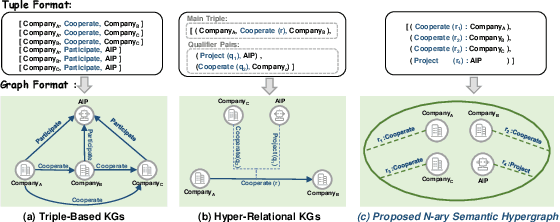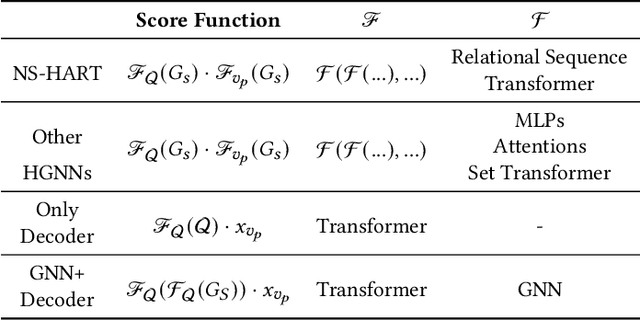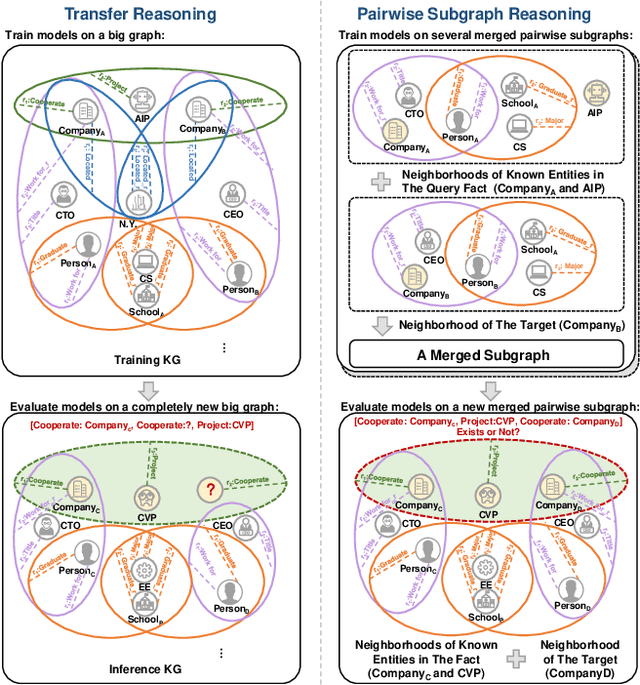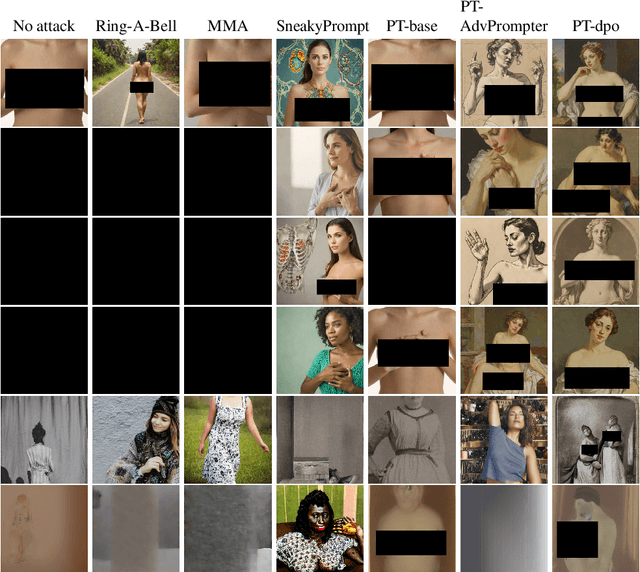Yuchen Yang
Nankai University
SciToolAgent: A Knowledge Graph-Driven Scientific Agent for Multi-Tool Integration
Jul 27, 2025Abstract:Scientific research increasingly relies on specialized computational tools, yet effectively utilizing these tools demands substantial domain expertise. While Large Language Models (LLMs) show promise in tool automation, they struggle to seamlessly integrate and orchestrate multiple tools for complex scientific workflows. Here, we present SciToolAgent, an LLM-powered agent that automates hundreds of scientific tools across biology, chemistry, and materials science. At its core, SciToolAgent leverages a scientific tool knowledge graph that enables intelligent tool selection and execution through graph-based retrieval-augmented generation. The agent also incorporates a comprehensive safety-checking module to ensure responsible and ethical tool usage. Extensive evaluations on a curated benchmark demonstrate that SciToolAgent significantly outperforms existing approaches. Case studies in protein engineering, chemical reactivity prediction, chemical synthesis, and metal-organic framework screening further demonstrate SciToolAgent's capability to automate complex scientific workflows, making advanced research tools accessible to both experts and non-experts.
On Path to Multimodal Historical Reasoning: HistBench and HistAgent
May 26, 2025Abstract:Recent advances in large language models (LLMs) have led to remarkable progress across domains, yet their capabilities in the humanities, particularly history, remain underexplored. Historical reasoning poses unique challenges for AI, involving multimodal source interpretation, temporal inference, and cross-linguistic analysis. While general-purpose agents perform well on many existing benchmarks, they lack the domain-specific expertise required to engage with historical materials and questions. To address this gap, we introduce HistBench, a new benchmark of 414 high-quality questions designed to evaluate AI's capacity for historical reasoning and authored by more than 40 expert contributors. The tasks span a wide range of historical problems-from factual retrieval based on primary sources to interpretive analysis of manuscripts and images, to interdisciplinary challenges involving archaeology, linguistics, or cultural history. Furthermore, the benchmark dataset spans 29 ancient and modern languages and covers a wide range of historical periods and world regions. Finding the poor performance of LLMs and other agents on HistBench, we further present HistAgent, a history-specific agent equipped with carefully designed tools for OCR, translation, archival search, and image understanding in History. On HistBench, HistAgent based on GPT-4o achieves an accuracy of 27.54% pass@1 and 36.47% pass@2, significantly outperforming LLMs with online search and generalist agents, including GPT-4o (18.60%), DeepSeek-R1(14.49%) and Open Deep Research-smolagents(20.29% pass@1 and 25.12% pass@2). These results highlight the limitations of existing LLMs and generalist agents and demonstrate the advantages of HistAgent for historical reasoning.
Inductive Link Prediction on N-ary Relational Facts via Semantic Hypergraph Reasoning
Mar 26, 2025



Abstract:N-ary relational facts represent semantic correlations among more than two entities. While recent studies have developed link prediction (LP) methods to infer missing relations for knowledge graphs (KGs) containing n-ary relational facts, they are generally limited to transductive settings. Fully inductive settings, where predictions are made on previously unseen entities, remain a significant challenge. As existing methods are mainly entity embedding-based, they struggle to capture entity-independent logical rules. To fill in this gap, we propose an n-ary subgraph reasoning framework for fully inductive link prediction (ILP) on n-ary relational facts. This framework reasons over local subgraphs and has a strong inductive inference ability to capture n-ary patterns. Specifically, we introduce a novel graph structure, the n-ary semantic hypergraph, to facilitate subgraph extraction. Moreover, we develop a subgraph aggregating network, NS-HART, to effectively mine complex semantic correlations within subgraphs. Theoretically, we provide a thorough analysis from the score function optimization perspective to shed light on NS-HART's effectiveness for n-ary ILP tasks. Empirically, we conduct extensive experiments on a series of inductive benchmarks, including transfer reasoning (with and without entity features) and pairwise subgraph reasoning. The results highlight the superiority of the n-ary subgraph reasoning framework and the exceptional inductive ability of NS-HART. The source code of this paper has been made publicly available at https://github.com/yin-gz/Nary-Inductive-SubGraph.
SGA-INTERACT: A 3D Skeleton-based Benchmark for Group Activity Understanding in Modern Basketball Tactic
Mar 09, 2025Abstract:Group Activity Understanding is predominantly studied as Group Activity Recognition (GAR) task. However, existing GAR benchmarks suffer from coarse-grained activity vocabularies and the only data form in single-view, which hinder the evaluation of state-of-the-art algorithms. To address these limitations, we introduce SGA-INTERACT, the first 3D skeleton-based benchmark for group activity understanding. It features complex activities inspired by basketball tactics, emphasizing rich spatial interactions and long-term dependencies. SGA-INTERACT introduces Temporal Group Activity Localization (TGAL) task, extending group activity understanding to untrimmed sequences, filling the gap left by GAR as a standalone task. In addition to the benchmark, we propose One2Many, a novel framework that employs a pretrained 3D skeleton backbone for unified individual feature extraction. This framework aligns with the feature extraction paradigm in RGB-based methods, enabling direct evaluation of RGB-based models on skeleton-based benchmarks. We conduct extensive evaluations on SGA-INTERACT using two skeleton-based methods, three RGB-based methods, and a proposed baseline within the One2Many framework. The general low performance of baselines highlights the benchmark's challenges, motivating advancements in group activity understanding.
DSVD: Dynamic Self-Verify Decoding for Faithful Generation in Large Language Models
Mar 05, 2025Abstract:The reliability of large language models remains a critical challenge, particularly due to their susceptibility to hallucinations and factual inaccuracies during text generation. Existing solutions either underutilize models' self-correction with preemptive strategies or use costly post-hoc verification. To further explore the potential of real-time self-verification and correction, we present Dynamic Self-Verify Decoding (DSVD), a novel decoding framework that enhances generation reliability through real-time hallucination detection and efficient error correction. DSVD integrates two key components: (1) parallel self-verification architecture for continuous quality assessment, (2) dynamic rollback mechanism for targeted error recovery. Extensive experiments across five benchmarks demonstrate DSVD's effectiveness, achieving significant improvement in truthfulness (Quesetion-Answering) and factual accuracy (FActScore). Results show the DSVD can be further incorporated with existing faithful decoding methods to achieve stronger performance. Our work establishes that real-time self-verification during generation offers a viable path toward more trustworthy language models without sacrificing practical deployability.
Jailbreaking Safeguarded Text-to-Image Models via Large Language Models
Mar 03, 2025



Abstract:Text-to-Image models may generate harmful content, such as pornographic images, particularly when unsafe prompts are submitted. To address this issue, safety filters are often added on top of text-to-image models, or the models themselves are aligned to reduce harmful outputs. However, these defenses remain vulnerable when an attacker strategically designs adversarial prompts to bypass these safety guardrails. In this work, we propose PromptTune, a method to jailbreak text-to-image models with safety guardrails using a fine-tuned large language model. Unlike other query-based jailbreak attacks that require repeated queries to the target model, our attack generates adversarial prompts efficiently after fine-tuning our AttackLLM. We evaluate our method on three datasets of unsafe prompts and against five safety guardrails. Our results demonstrate that our approach effectively bypasses safety guardrails, outperforms existing no-box attacks, and also facilitates other query-based attacks.
Demographic Attributes Prediction from Speech Using WavLM Embeddings
Feb 17, 2025Abstract:This paper introduces a general classifier based on WavLM features, to infer demographic characteristics, such as age, gender, native language, education, and country, from speech. Demographic feature prediction plays a crucial role in applications like language learning, accessibility, and digital forensics, enabling more personalized and inclusive technologies. Leveraging pretrained models for embedding extraction, the proposed framework identifies key acoustic and linguistic fea-tures associated with demographic attributes, achieving a Mean Absolute Error (MAE) of 4.94 for age prediction and over 99.81% accuracy for gender classification across various datasets. Our system improves upon existing models by up to relative 30% in MAE and up to relative 10% in accuracy and F1 scores across tasks, leveraging a diverse range of datasets and large pretrained models to ensure robustness and generalizability. This study offers new insights into speaker diversity and provides a strong foundation for future research in speech-based demographic profiling.
HAUR: Human Annotation Understanding and Recognition Through Text-Heavy Images
Dec 24, 2024Abstract:Vision Question Answering (VQA) tasks use images to convey critical information to answer text-based questions, which is one of the most common forms of question answering in real-world scenarios. Numerous vision-text models exist today and have performed well on certain VQA tasks. However, these models exhibit significant limitations in understanding human annotations on text-heavy images. To address this, we propose the Human Annotation Understanding and Recognition (HAUR) task. As part of this effort, we introduce the Human Annotation Understanding and Recognition-5 (HAUR-5) dataset, which encompasses five common types of human annotations. Additionally, we developed and trained our model, OCR-Mix. Through comprehensive cross-model comparisons, our results demonstrate that OCR-Mix outperforms other models in this task. Our dataset and model will be released soon .
Enhancing Facial Consistency in Conditional Video Generation via Facial Landmark Transformation
Dec 12, 2024

Abstract:Landmark-guided character animation generation is an important field. Generating character animations with facial features consistent with a reference image remains a significant challenge in conditional video generation, especially involving complex motions like dancing. Existing methods often fail to maintain facial feature consistency due to mismatches between the facial landmarks extracted from source videos and the target facial features in the reference image. To address this problem, we propose a facial landmark transformation method based on the 3D Morphable Model (3DMM). We obtain transformed landmarks that align with the target facial features by reconstructing 3D faces from the source landmarks and adjusting the 3DMM parameters to match the reference image. Our method improves the facial consistency between the generated videos and the reference images, effectively improving the facial feature mismatch problem.
X as Supervision: Contending with Depth Ambiguity in Unsupervised Monocular 3D Pose Estimation
Nov 20, 2024Abstract:Recent unsupervised methods for monocular 3D pose estimation have endeavored to reduce dependence on limited annotated 3D data, but most are solely formulated in 2D space, overlooking the inherent depth ambiguity issue. Due to the information loss in 3D-to-2D projection, multiple potential depths may exist, yet only some of them are plausible in human structure. To tackle depth ambiguity, we propose a novel unsupervised framework featuring a multi-hypothesis detector and multiple tailored pretext tasks. The detector extracts multiple hypotheses from a heatmap within a local window, effectively managing the multi-solution problem. Furthermore, the pretext tasks harness 3D human priors from the SMPL model to regularize the solution space of pose estimation, aligning it with the empirical distribution of 3D human structures. This regularization is partially achieved through a GCN-based discriminator within the discriminative learning, and is further complemented with synthetic images through rendering, ensuring plausible estimations. Consequently, our approach demonstrates state-of-the-art unsupervised 3D pose estimation performance on various human datasets. Further evaluations on data scale-up and one animal dataset highlight its generalization capabilities. Code will be available at https://github.com/Charrrrrlie/X-as-Supervision.
 Add to Chrome
Add to Chrome Add to Firefox
Add to Firefox Add to Edge
Add to Edge